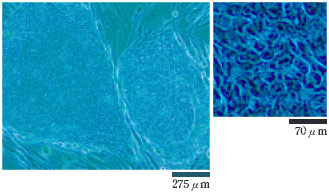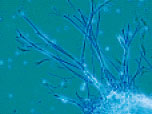Embryonic Stem Cells in Regenerative Medicine
Embryonic Stem Cells and Embryonic Development from Fertilized Ova
How are our bodies formed? Cell division commences within a fertilized ovum. When it has become a spherical early embryo, it implants itself in the lining of the uterus. There, it shapes itself into a fetus, builds many different tissues and organs, after which it grows and is born into the world. When it implants itself, the ovum is a blastocyst, consisting of some 100 cells. All organs that make up the body of the fetus are created by a group of cells known as the inner cell mass (ICM), which are the ultimate stem cells. By adopting special methods to extract and culture these cells, we can establish cell lines that continue to divide. The amazing thing about this is that we can proliferate them indefinitely, while preserving them in an undifferentiated state, thus creating what are known as embryonic stem cell (ES cell) lines (Fig. 1).

Fig.1 : Establishment ES cell lines from blastocysts and utilization for cell therapy in regenerative medicine. Abbreviations: ICM, Inner Cell Mass; EG, Embryonic Germ cell; ES, Embryonic Stem cell
Potentials for Regenerative Medicine Using Embryonic Stem Cells
Given the unlimited capability for proliferation in embryonic stem cells, the focus is on the application of them for regenerative medicine. These cells possess not only the ability to proliferate themselves in tremendous quantities, ad infinitum, but also to differentiate into all the cells and tissues that form the human body, thus making it possible to supply all types of cell, in quantity, to repair damaged tissue. It is this combination of unlimited proliferation and ability to differentiate that make them so attractive across a wide range of medical applications (Fig. 1).
Examples include new and breakthrough treatments for such disorders as Parkinson's disease, in which dopamine secreting neurons die off; damage on the spinal cord by accidents or other reasons, wherein nerve fibers are severed; diabetes, wherein the Islets of Langerhans do not secrete insulin properly; cirrhosis of the liver, wherein liver cell function declines; and myocardial infarction, wherein heart function declines due to heart muscle cells dying off. In other words, this method of cellular treatment-- of restoring organ function by transplanting healthy cells that function normally to where they are needed--is the core of regenerative medicine. Large quantities of human cells that perform desired functions are needed to bring about cellular treatment, which are not obtained by the traditional tissue donation. The goal, therefore, is to differentiate embryonic stem cells into desired cell types, once they have been proliferated in quantity in their undifferentiated, pluripotent state. Having done so, we then gather the differentiated cells that perform the required function, and use them in transplant therapy for patients.
Establishing Human Embryonic Stem Cell Lines
Several years ago, we succeeded in efficiently establishing embryonic stem cell lines from the blastocysts of crabeating macaques that were used for experimental purposes. At the Kyoto University Institute for Frontier Medical Sciences, expanding this success, we are conducting the research to establish human embryonic stem cell lines, which are not made in the other laboratories in Japan. The objective of this effort is to establish cell lines with superior pluripotential quality and with no concern about viral contamination, that can then be distributed far and wide to Japanese researchers, who can then use them without fear of restrictions such as intellectual property issues. According to Japanese government policy regarding establishment and use of human embryonic stem cell lines (Table 1), agencies that have received government authorization for establishment of cell lines are obligated to distribute the stem cells they create, either for free or at cost, to research agencies that have themselves received government authorization for stem cell use and research. By distributing highquality human embryonic stem cell lines to research agencies nationwide, we are establishing a system that will contribute to the advancement of research into regenerative medicine using stem cells in our country.
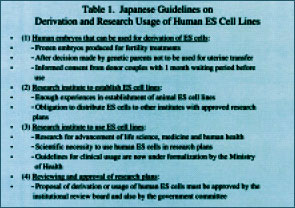
Table 1
Human embryos that would be used for the establishment of embryonic
stem cell lines are limited to those with strict conditions as follows. They were produced from the infertility treatments and kept frozen, but later they were determined not to be used for that purpose. Explaining thoroughly the research purpose to the donors and related persons, we would receive consents from them to use embryos to establish embryonic stem cell lines. Upon receipt of authorization for our cell line establishment project by the Minister of Education, Culture, Sports, Science and Technology in April 2002, we at the Institute for Frontier Medical Sciences proceeded cautiously with a process that would lead to offers of frozen embryos, and were at last able to commence thawing and experimenting in January 2003 on frozen embryos that were thus given to us (Fig. 2). While we did face the difficulty of having a very small number of frozen embryos available to us, we have been fortunate in being able to successfully establish three cell lines as of November 2003 (Fig. 3). These human embryonic stem cell lines are proliferating steadily, and differentiating into neurons and other cells in culture dishes (Fig. 4). They also have the ability to differentiate into all types of tissue when transplanted into immunodeficient mice. We commence stem cell distribution to domestic researchers in March 2004.
The Need for Human Cells in Medical Research
While the importance of embryonic stem cells for cell transplanting is drawing attention, human cells of all types are in fact essential in medical and pharmaceutical research. There is a particularly great need for human cells for use as research material in drug development, as well as drug safety and toxicity tests. For example, liver cells are the most appropriate matter to administer new drug candidates to examine the way how these substances are metabolized and to test their toxicity and safety, because they are at the center of the metabolism of drugs. There is a tremendous difference, between the way substances are metabolized by humans and laboratory animals that makes testing on human liver cells essential. There are, however, serious restrictions on the supply and acquisition of human tissue cells. With embryonic stem cells, however, we can produce the cells that we need, after proliferating them in quantity. Furthermore, we can also produce cells with modified genes, for specific testing purposes. Why are embryonic stem cells referred to as omnipotent? The answer lies in the fact that they have both unlimited proliferating ability and can also differentiate into practically any and all cell types.
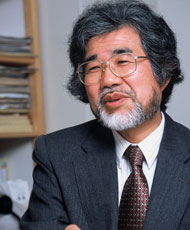
Norio Nakatsuji
Born in 1950.
Graduate of the doctoral program, Graduate School of Science, Kyoto University
D.Sc., Kyoto University
Professor, Institute for Frontier Medical Sciences, Kyoto University
URL Institute for Frontier Medical Sciences, Kyoto University (External Link)
"As a scientist, choosing to do research in creating human embryonic stem cell lines was a major decision."
Professor Nakatsuji has something of great personal value: a bundle of letters from critically ill patients. All of them learned of the results of his research primarily through newspaper articles, and found a flicker of hope therein. Unlike the glowing media reports, however, the Professor's research becomes a lot less glamorous once he has formulated the techniques for culturing stem cell lines. Most of his work after that point consists of repetitive processes. The benefits to medical research as a whole of stable supplies of embryonic stem cells are incalculable. From the standpoint of the scientist, however, who constantly desires to search for new truths, such is by no means an ideal choice of path. What keeps him going in this way is "a sense of duty to contribute to society," he says. And it is his personal treasure,a bundle of letters, that gives him that sense.
In describing himself as a basic scientist, the Professor says that he is supported by society, which is why he puts his heart and soul into how to deal with that society in good faith. His attitude is warm and invigorating, and informs us all as to what foundation to use in building relationships of trust between science and society.
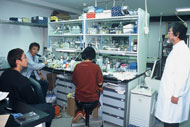
Prof. Nakatsuji talks about the experiments with students in the laboratory.



